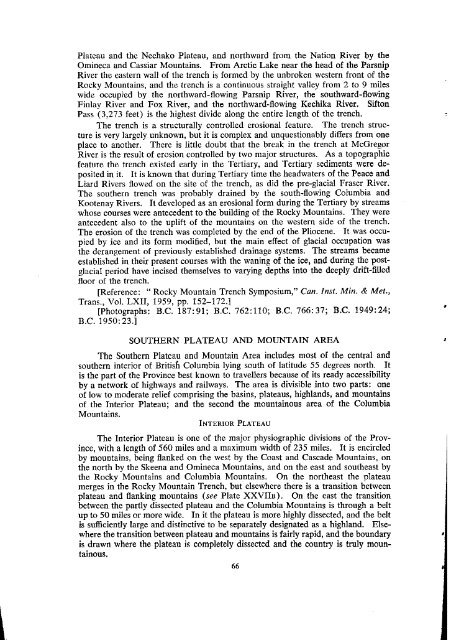Landforms of British Columbia 1976 - Department of Geography
Landforms of British Columbia 1976 - Department of Geography
Landforms of British Columbia 1976 - Department of Geography
Create successful ePaper yourself
Turn your PDF publications into a flip-book with our unique Google optimized e-Paper software.
Plateau and the Nechako Plateau, and northward from the Nation River by the<br />
Omineca and Cassiar MotWains. From Arctic Lake near the head <strong>of</strong> the Parsnip<br />
River the eastern wall <strong>of</strong> the trench is formed by the unbroken western front <strong>of</strong> the<br />
Rocky Mountains, and the trench is a continuous straight valley from 2 to 9 miles<br />
wide occupied by the northward-flowing Parsnip River, the southward-flowing<br />
Finlay River and Fox River, and the. northward-flowing Kechika River. Sifton<br />
Pass (3,273 feet) is the highest divide along the entire length <strong>of</strong> the trench.<br />
The trench is a struc~orally controlled erosional feature. The trench structure<br />
is very largely unknown, but it is complex and unqoes~ionably differs from one<br />
place to another. There is little doubt that the break in the trench at McGregor<br />
River is the result <strong>of</strong> erosion controlled by two major structures. As a topographic<br />
feature the trench existed early in the Tertiary, and Tertiary sediments were deposited<br />
in it. It is known that during Tertiary Gme. the headwaters <strong>of</strong> the Peace and<br />
L&d Rivers flowed on the site <strong>of</strong> the trench, as did the pre-glacial Fraser River.<br />
The southern trench was probably drained by the south-flowing <strong>Columbia</strong> and<br />
Kootenay Rivers. It developed as an erosional form during the Tertiary by streams<br />
whose courses were antecedent to the building <strong>of</strong> the Rocky Mountains. They were<br />
antecedent also to the uplift <strong>of</strong> the mountains on the western side <strong>of</strong> the trench.<br />
The erosion <strong>of</strong> the trench was cornpl&ed by the end <strong>of</strong> the Pliocene. It was occopied<br />
by ice and its form modified, but the main effect <strong>of</strong> glacial occupation was<br />
the derangement <strong>of</strong> previously established drainage systems. The &earns became<br />
established in their present courses with the waning <strong>of</strong> the ice, and during the postglacial<br />
period have incised themselves to varying depths into the deeply drift-filled<br />
floor <strong>of</strong> the trench.<br />
[Reference: “ Rocky Mountain Trench Symposium: Can. Inst. Min. c? Met.,<br />
Trans., Vol. LXII, 1959, pp. 152-172.1<br />
[Photographs: B.C. 187:91; B.C. 762:llO; B.C. 766:37; B.C. 1949:24;<br />
B.C. 1950: 23.1<br />
SOUTHERN PLATEAU AND MOUNTAIN AREA<br />
The Southern Plateau and Mountain Area includes most <strong>of</strong> the central and<br />
southern interior <strong>of</strong> <strong>British</strong> <strong>Columbia</strong> lying south <strong>of</strong> latitude S5 degrees north. It<br />
is the part <strong>of</strong> the Province best known to travellers because <strong>of</strong> its ready accessibility<br />
by a nework <strong>of</strong> highways and railways. The area is divisible into two parts: one<br />
<strong>of</strong> low to moderate relief comprising the basins, plahzus, highlands, and moo&&s<br />
<strong>of</strong> the Interior Pla&m; and the second the mounGnous area <strong>of</strong> the <strong>Columbia</strong><br />
MounWins.<br />
The Interior Plateau is one <strong>of</strong> the major physiographic divisions <strong>of</strong> the Prov-<br />
ince, with a length <strong>of</strong> 560 miles and a maximum width <strong>of</strong> 235 miles. It is encircled<br />
by mountains, being flanked on the west by the Coast and Cascade Mountains, on<br />
the north by the Skeena and Omineca Mountains, and on the east and southeast by<br />
the Rocky MooWains and <strong>Columbia</strong> Mountains. On the northeast the plateau<br />
merges in the Rocky Mountain Trench, but elsewhere there is a transition between<br />
plateau and flanking mountains (see Plate XXVIIB). On the east the transition<br />
between the. partly dissected plateau and the Colombia MounGx is through r~ beIt<br />
up to 50 miles or more wide. In it the plateau is more highly dissected, and the belt<br />
is sufliciently large and distinct& to be separately designated as a highland. Else-<br />
where the transition between plateau and rnounGns is fairly rapid, and the. boundary<br />
is drawn where the plateau is completely dissected and the country is truly moon-<br />
Gmus.<br />
66<br />
,











